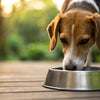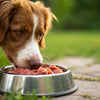Can Raw Dog Food Make Dogs Sick? A Comprehensive Guide for Pet Owners
- Houndsy
Table of Contents
- Introduction
- Understanding Raw Dog Food
- The Risks of Feeding Raw Dog Food
- The Balance: Benefits vs. Risks
- Reflections on Your Feeding Routine
- Conclusion
Introduction
Did you know that an estimated 1.2 million people in the U.S. fall ill from Salmonella each year, partly due to foodborne pathogens? As caring dog owners, many of us strive to provide the best nutrition possible for our furry companions. Recently, a growing trend has emerged among pet parents: the shift to raw dog food diets, often touted as the most natural and nutritious option. But as tempting as it may seem, one pressing question arises in the minds of conscientious pet owners: can raw dog food make dogs sick?
In this blog post, we will delve into the nuances surrounding raw dog food, exploring its potential risks and benefits while offering practical advice on how to navigate this complex dietary choice. By the end, you'll gain an informed perspective that can enhance both your and your dog’s mealtime experience. We will discuss the risks associated with harmful bacteria, the nutritional adequacy of raw diets, and how to implement safe practices if you do choose this route. Along the way, we will seamlessly weave in our dog-feeding philosophy at Houndsy, emphasizing our commitment to designing beautiful, functional products that elevate the pet feeding experience.
As we dive deeper into the world of raw dog food, we encourage you to reflect on your current pet feeding regimen. Are you fully aware of what goes into your dog's bowl? Let's discover together whether switching to a raw diet is the right choice for you and your beloved pet.
Understanding Raw Dog Food
What Constitutes Raw Dog Food?
Raw dog food is typically characterized by its uncooked animal meat, bones, and, in some instances, fruits and vegetables. Ingredients often include:
- Raw muscle meat (like chicken, beef, or lamb)
- Raw organs (such as liver or kidneys)
- Whole bones (which can be safe if properly prepared)
- Raw eggs and dairy
- Fruits and vegetables (like carrots and blueberries)
These components are designed to mimic the ancestral diet of canines, aiming to provide a more natural feeding option for our pets.
Popularity of Raw Diets
The increase in raw dog food's popularity can be traced back to the BARF diet, an acronym for Bones and Raw Food or Biologically Appropriate Raw Food, developed by Australian veterinarian Ian Billinghurst in the early 1990s. This diet claims to cater to dogs' natural canine instincts and nutritional needs. Despite rising interest, many veterinarians and pet owners remain concerned about the safety and efficacy of raw diets.
The Risks of Feeding Raw Dog Food
Potential Pathogens in Raw Meats
Feeding raw dog food can significantly increase your dog's risk of exposure to harmful bacteria. A comprehensive study conducted by the FDA's Center for Veterinary Medicine revealed that raw pet food is more likely to be contaminated with pathogens like Salmonella and Listeria monocytogenes than other types of dog food. In fact, among 196 samples of commercial raw pet food tested, 15 were positive for Salmonella, while 32 tested positive for Listeria monocytogenes.
Impacts on Dogs
- Salmonella can cause severe gastrointestinal issues in dogs, leading to symptoms such as vomiting, diarrhea, lethargy, and loss of appetite.
- Listeria can affect the nervous system and can be particularly dangerous for pregnant dogs and those with weakened immune systems.
The implications extend beyond our pets. Pets can shed these pathogens, posing a risk to their human caregivers—especially those who are immunocompromised, elderly, or have young children.
Nutritional Concerns
While raw diets often appear to be rich in protein, they may lack crucial nutrients that your dog requires to thrive. Achieving a balanced diet with homemade raw food requires meticulous planning and, preferably, consultation with a veterinary nutritionist. If not carefully curated, raw diets can lead to deficiencies in specific vitamins or minerals, which can ultimately affect your dog's health.
Food Safety Practices
If you decide to venture into the realm of raw feeding, implementing rigorous safety practices is paramount. Here are some essential tips:
- Wash Hands and Surfaces: Thoroughly wash your hands with soap and water after handling raw dog food. Clean and disinfect any surfaces that have been in contact with raw ingredients to minimize cross-contamination.
- Separate Preparation Areas: Use designated kitchen utensils and cutting boards to prepare raw dog food, keeping them separate from your human food to avoid cross-contact.
- Safe Storage: Store raw dog food in sealed containers, and keep it frozen until ready to use. Thaw raw food in the refrigerator rather than at room temperature.
- Monitor and Discard Leftovers: Supervise your dog while feeding and promptly discard any uneaten food that has been left out for too long.
The Balance: Benefits vs. Risks
While there are risks associated with feeding raw dog food, some proponents of raw diets highlight potential benefits, citing improvements in coat condition, energy levels, and dental health. However, these claims must be weighed against the considerable risks mentioned.
Advantages of Raw Feeding
- Improved Coat Condition: Pet owners often note shinier coats in dogs on raw diets, likely due to a higher fat content.
- Dental Health: Chewing on raw bones can help clean dogs’ teeth, reducing plaque buildup. However, it’s crucial that the bones are appropriately sized and prepared to prevent choking hazards.
- Enhanced Digestion: Some dog owners report improved stomach health and digestion due to the higher moisture content in raw diets.
The Case for Cooked or Kibble Diets
Many veterinary experts maintain that the risks associated with raw diets outweigh the potential benefits. Alternatives like high-quality kibble, which undergoes thorough cooking to eliminate pathogens, can deliver complete and balanced nutrition without the accompanying health hazards.
At Houndsy, we emphasize the importance of convenience and safety in pet feeding, which is why our flagship product, the Houndsy Kibble Dispenser, is designed to provide perfectly portioned meals while reducing mess and hassle during feed time. Invest in a feeding solution that offers both reliability and style—skipping the messy raw food process doesn't mean compromising on quality!
Reflections on Your Feeding Routine
As we navigate the conversation around raw dog food, it's worth reflecting on your current feeding routine. Are you confident in the nutritional adequacy of your dog's diet? How do you ensure safety while preparing their meals? Engaging with these questions can empower you to make informed decisions that benefit your furry friend.
Conclusion
The question of whether raw dog food can make dogs sick brings us face-to-face with critical issues related to pet health and nutrition. The risks associated with harmful bacteria and nutritional deficiencies can be concerning. While some pet owners swear by the benefits of raw feeding, extensive evidence points towards cooked diets offering a safer and more balanced alternative.
If you're still weighing the pros and cons of raw feeding, we invite you to consider the Houndsy Kibble Dispenser as a sophisticated solution for your dog’s mealtime. With its ergonomic design and excellent portion-control features, we take the guesswork out of dog feeding, ensuring your pet receives a balanced meal without the risks associated with raw diets.
Feel free to explore our product offerings further and consider transitioning to a simpler, safer dog feeding routine!
Frequently Asked Questions
1. What are the risks of feeding raw dog food?
Raw dog food can be contaminated with harmful bacteria like Salmonella and Listeria, which pose risks to both dogs and their human caregivers. Additionally, raw diets can lead to nutritional deficiencies if not formulated correctly.
2. Are there any health benefits to raw dog food?
Some pet owners report improvements in coat condition, energy levels, and dental health. However, veterinary experts often emphasize that these potential benefits do not outweigh the risks associated with feeding raw diets.
3. What safe practices should I implement if I choose to feed raw dog food?
Key practices include washing hands and surfaces after handling, keeping raw food separate from human foods, storing foods safely, and discarding leftovers.
4. Is raw dog food nutritionally adequate?
It can be, but it requires careful planning. Many homemade raw diets lack essential nutrients and should ideally be formulated by a veterinary nutritionist.
5. What alternatives are there to raw dog food?
High-quality kibble and freshly cooked meals are excellent alternatives that provide balanced nutrition without the associated risks of raw feeding. Explore our Houndsy Kibble Dispenser for convenience and style in serving dog food.
By keeping these factors in mind, you can ensure that you provide your dog with a safe, nutritious, and enjoyable dining experience.












